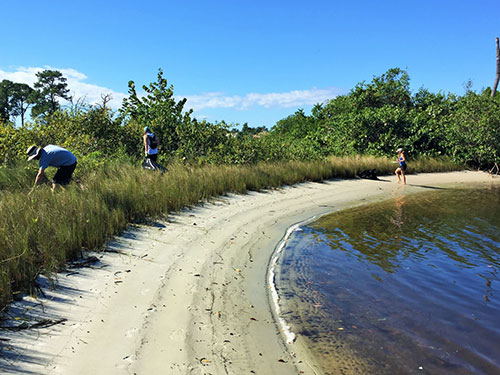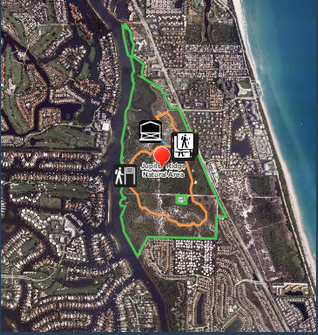The Snook and Gamefish Foundation (SGF) partnered with Palm Beach County Environmental Resources Management (ERM) to work together in the upkeep and protection of 271 acres of land and coastline known as the Jupiter Ridge Natural area. Jeff Buck, an Environmental Analyst with the Palm Beach County Environmental Resources Management, took the lead as SGF's Volunteer crew met on October 23rd at the Jupiter Ridge parking lot, located on A1A north of Donald Ross Blvd in Palm Beach County. Jeff was there to assist us all in his knowledge of the lay of the land.
It was a beautiful crisp morning and everyone seemed to have a skip in their step. Brett Fitzgerald, the Executive Director of SGF, announced to everyone that we would be beginning our day with the coastal cleanup. Half of the volunteers went by foot to walk and climb through the mangroves to clean up any rubbish that had washed up to shore. We had a little over an hour of tide that was low enough for us to walk along an area that’s called “Ski Beach”, which gets a lot of visitation during low tide, especially on the weekends. The other half of the volunteers went on the water with kayaks and scavenged up all they could find in the tidal creeks.

For me, deciding to go by foot ended up becoming an educational day. That’s where Jeff was helping out, and although he might not have planned it this way, maybe his biggest job was to answer all of our questions we had along the way. Jeff first pointed out that most of the shoreline is now protected by the oyster reef/breakwaters that were strategically installed by ERM, and native vegetation such as red mangroves, sea purslane and seashore paspalum which has been slowly recruiting into previously impacted/eroded areas. The seagrass population, which includes Johnson’s seagrass, shoal grass, paddle grass and manatee grass has remained sparse but persistent along the shoreline.
Jeff explained the difference between three species of mangroves: white, black, and red. Red mangroves are what people are most familiar with even if they didn’t know they were called, “red mangroves”. They are the ones you see creeping along the coastline with long roots that look like legs which the tree stands on along the coastline. On the shallow side of red mangroves is where you might encounter black mangroves, with their dark brown pencil-like root shoots reaching up from the sand.

Jeff pointed out the salt that was encrusted on the leaves of the black mangroves. This mangrove species looked more like a tree to me with the soft leaves and dark and scaly bark. The shoots that come peeking out from the roots underground help the tree to breathe in oxygen. They made me think of tiny cave stalagmites. I wasn’t able to see the white mangrove Jeff described, but now I know that they live further inland and are similar to black mangroves in the sense of their roots.
Back in 1950 a wildfire burned down the majority of the natural area, but today in 2016 you could never tell that it ever occurred based on all of the vegetation.
Whether by foot or by kayak, everyone was finding rubbish left and right of where they looked. Altogether we removed a grand total of sixty pounds. We can only imagine how much more we could have achieved if there had been more volunteers. Notable to some of the volunteers was that we did not see any fishing line, even though many of us were looking specifically for it.
Trash is not the only issue facing the Jupiter Ridge area. Over 140 feet of shoreline was lost to erosion since 1940 with an estimate of 225 feet in height in the most impacted areas. In 2012 ERM completed a shoreline restoration project along the IWC covering 7,600 feet of frontage along the western portion, which lines the Intracoastal Waterway. The project was intended to reduce shoreline erosion and to enhance estuarine habitat. ERM was hoping to protect some 6,000 feet of mangrove and scrub shoreline and about 3.5 acres of existing seagrass habitat from boat wake disturbance.
A series of 21 oyster reef/breakwaters were built parallel to the shoreline. They were designed to promote flushing and tidal flow through gaps that were intentionally left at strategic points along the breakwaters. They now help stabilize sand and sediment that was previously washing into the IWC channel. Limestone boulders were also used to construct the project, which provided habitat and substrate for estuarine fish and invertebrates.
We all worked up quite an appetite from trekking and paddling our ways on the coastline. As we all returned back to our compound, we were all excitedly sharing our bizarre finds while cleaning up the coast. For a moment all you could hear was the cracking open of canned water and the noshing of sub sandwiches. A Florida scrub-jay flew overhead of us and Jeff told us to keep an eye out for an osprey nest that’s on the coastline which we’d be able to see from the kayaks. (I spotted it later, but only because I had heard a woodpecker on a tree and it happened to be the same tree.)
Some of the volunteers parted ways by this time, but the remainders went out in kayaks to begin a friendly fishing tournament. We all had a few bites but no catches. Though not catching any fish, it was still a beautiful day and a lot to take in of the serene coastline, and the “no catch” data was logged into the Angler Action Program (AAP). I watched Brett with his precise casting and he gave me a tip for prospecting new waters - wherever you can find white bleached out mangroves, you’ll might find some snook hanging out under there. Now I’ll just need to work on my precision of my cast so I’m actually catching snook and not just mangrove roots!
After a full day in the sun, we all met up at Due South Brewing and Company to sit and relax with an ice cold beer in our hand while discussing what we should all do at our next meetup at the Jupiter Ridge Natural Area. While already a beautiful gem of a spot in Palm Beach County, the land and coastline still has much potential for environmental improvements. We talked about planting some seagrass or placing some oyster beds to help cleanse the water of the murkiness it currently has. Jeff explained that before a planting project could take place, the ground elevations and tidal ranges should be evaluated in the potential planting areas to ensure the success and survival of the plantings. Oysters have recruited naturally on the surface of the limestone boulders that comprise the breakwaters, so ERM already knows the site conditions are conducive for oysters.
We can’t wait to gather up our volunteers again to have another great day at Jupiter Ridge Natural Area. Keep checking in with us at www.snookfoundation.org for the next meet up, as well as other social and volunteer opportunities. Also, please consider joining SGF as your membership always helps us in our mission to ensure a brighter fishing future for generations to come.
